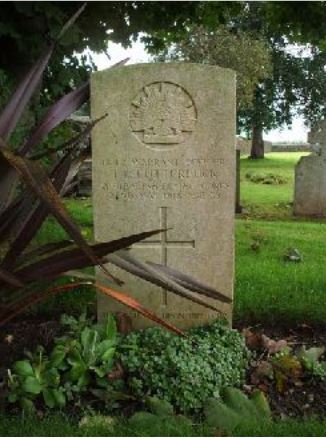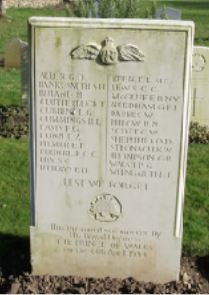8th Training Squadron, Australian Flying Corps

Thomas Clutterbuck was born at Bedminster, Bristol on 1 September 1877, the son of Andrew Sydney and Beda Thealia Clutterbuck. His father, a steam tramcar engine driver, had been a corporal in the Artillery, who had served in the Zulu War.
On 11 November 1893 the family (parents plus at least four children, of which Thomas was one) arrived in Australia on board the immigrant ship Zamora and settled in Brisbane, Queensland.
Prior to the Boer War Thomas had enlisted in the 2nd Queensland Mounted Infantry and he saw service in that war, between March 1900 and 1901, for which he was awarded a Queen’s South African Medal. He served with the Mounted Infantry for three years.
On 12 October 1902 he married Annie Hinson, at Kangeroo Point, Brisbane and the couple had two daughters (Dorris and Joyce) and a son (Frank) and lived at Ipswich, in the south-western part of Brisbane. By 1909 the marriage had broken down and Annie left Thomas, allegedly due to ‘his bad temper’. He was due to pay maintenance to his wife and children but only did so for six weeks before disappearing.
It seems likely that he continued his trade as a mechanical engineer somewhere and this may have been in New Zealand, as between 28 August and 17 September 1914 he served with the Auckland Regiment, during the capture of German territory of Samoa.
He was back in Australia by 19 May 1915, when he enlisted in the Australian Army, was given the number 1342 and placed in the 8th Re-enforcements (Engineers), as a driver with 1/7 Company. He stated his age, correctly, as 38 years and nine months.
On 15 September 1915 he embarked from Melbourne on the SS Marikini and by 25 October 1915 he had joined the ANZAC forces at Gallipoli, where he served until 27 December 1915. Upon the evacuation of Gallipoli, he was sent to Alexandria, Egypt, joining 1 Field Company, 1st Australian Division.
His stay in Egypt lasted until 21 March 1916, when he sailed for Marseilles, to join the British Expeditionary Force in France. On 1 May he reverted to the status of sapper, rather than driver.
In July 1916 the 1st Australian Division was heavily involved in fighting, as part of the Somme Offensive. On the 23rd of the month Sapper Clutterbuck was taken to 2nd Field Ambulance suffering from shell shock: he transferred to a Casualty Clearing Station and on 7 August was sent to England on board the Hospital Ship Asturies. On the following day he was admitted to 3rd London General Hospital at Wandsworth, where he was treated for septic sores and mild shell shock.
Having been discharged from hospital he was sent to the Australian Imperial Force (AIF) Depot at Perham Down, Wiltshire, to await his posting. Initially this was to Wareham, Dorset on 27 October 1916 before he returned to Perham Down on 3 April 1917.
He then made the transfer to the Australian Flying Corps (AFC) and 30 Squadron at Tern Hill, Shropshire. Promotion quickly followed, first to Serjeant on 17 May and to Flight Serjeant a month later. On 31 July 1917 he was posted to the Central Flying School at Upavon, Wiltshire, staying until a posting to 38 Training Squadron at Tern Hill, Shropshire. Here he was promoted to Warrant Officer on 26 October 1917.
He remained at Tern Hill until 5 March 1918 (having transferred to 33 Training Squadron on 8 January 1918), when his final posting was to 8 Training Squadron at Leighterton, Gloucestershire.
On 22 May 1918 he was in the George Hotel, Nailsworth when he suffered fatal cardiac failure, aged 40. He was buried, with military honours, at Leighterton Church Cemetery, on 25 May 1918. A CWGC headstone now marks his grave.
His death precipitated a dispute between his sister (Mrs A Fox) and his estranged wife. As Annie Clutterbuck had left Thomas, Mrs Fox saw herself as the next of kin, however, Annie believed that, being still married to him, she should be considered as such. There was also the question of the lack of maintenance payments and the distribution of any pension or gratuity monies. There was also the question as to who should receive the medals due to Thomas, to reflect his service. The authorities came down in favour of Annie, notwithstanding the production of a will, written in favour of Mrs Fox, dated 4 January 1918.
There was a curious situation regarding Thomas’ medal entitlement. The New Zealand Government issued him with a 1914-15 Star, to reflect his service in Samoa. The Australian Government did the same, in respect of his service with the ANZACs in Gallipoli. The rules precluded the issuance of two identical medals relating to the same war and so, in 1923, Annie Clutterbuck returned the New Zealand issued one.

Researched by Graham Adams 13 January 2018
